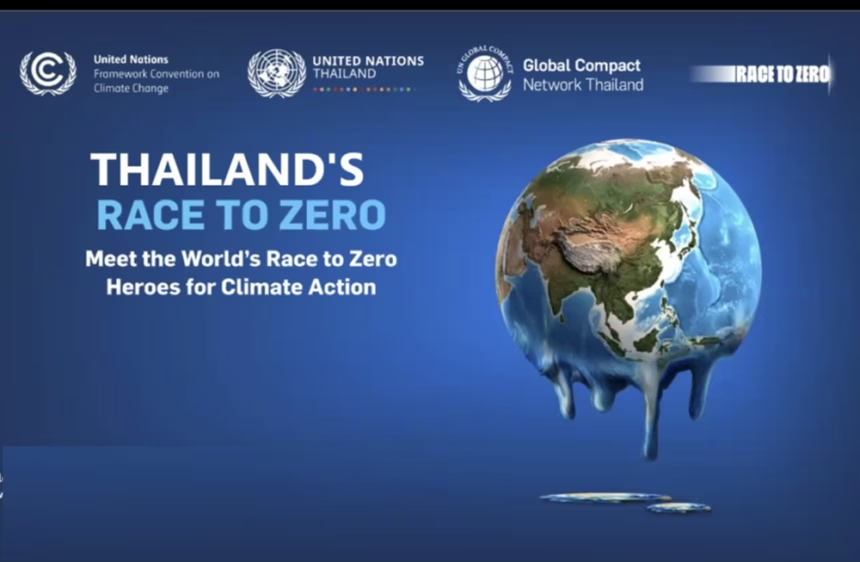Thailand is in a sprint to a cleaner future. The country has raised its climate ambition, targeting carbon neutrality by 2050 and deeper cuts by 2035. What does that really mean? Carbon neutrality means balancing greenhouse gases released with those removed from the atmosphere.
Net zero means the same across all gases and sectors, with very limited offsets. The aim is simple: cut most emissions at the source, then use nature and technology to mop up the rest.
This shift is not just for the climate. It touches energy security, jobs, health, and trade. Lower fuel imports, cleaner air, and new industries around renewables and batteries can boost growth.
As of November 2025, the roadmap pairs a stronger 2035 target with sector plans in power, transport, industry, land and forestry, and waste. It sits alongside early steps on carbon pricing and a push to scale clean energy fast.
Here is a clear walk-through of the plan, the near-term actions that matter, the biggest risks, and the fixes that keep Thailand on track.
Thailand’s 2050 Carbon Neutrality Roadmap at a Glance
Thailand has upgraded its climate goals. The country plans to hit net zero emissions by 2050, earlier than its previous 2065 pledge. The 2035 checkpoint is tighter too, aiming for a 47 percent cut from 2019 levels, with a cap close to 152 million tons of CO2 equivalent. Near-term action by 2030 locks in that trajectory.
Five sectors carry the load: energy, transport, industry, land use and forestry, and waste. The plan puts heavy weight on clean power, electric mobility, industrial efficiency, and a larger carbon sink from forests and mangroves. It also expects emissions to peak around 2025, then decline steadily.
Why the acceleration in 2025? Pressure from trade partners and the real risk of falling behind on clean technology pushed for a faster timeline. Ministries coordinate the roadmap and track annual progress with sector indicators, public reports, and updates to the UN. Think of a simple milestone bar that shows yearly progress, with data on renewable capacity, EV sales share, reforested land, and landfill methane capture.
Clear Targets and Milestones (2030, 2035, 2050)
- 2030: Lock in rapid growth in solar, wind, and storage; scale EV charging; launch large efficiency programs.
- 2035: Cut emissions 47 percent vs 2019, cap near 152 MtCO2e; deep power sector shift; EV share rising fast; stronger forest sink.
- 2050: Net zero emissions, with most cuts at the source and limited high-quality removals.
Near-term actions by 2030 make the 2035 target possible. Side note for readers: carbon neutrality means balance of emissions and removals, net zero is the same but with higher precision across all gases, and an emissions cap is a ceiling that total emissions must not exceed.
Who Leads and How Progress Is Measured
Policy leadership spans several ministries. Energy steers power supply and efficiency. Transport guides EVs, charging, public transit, and fuel rules. Industry and finance shape incentives, tax signals, and green investment. Agriculture, forestry, and the environment manage land use, sinks, and methane. Annual reviews check progress, with national reporting to the UN and sector data like renewable capacity added, EV sales share, reforestation area, and landfill methane captured.
Why the Plan Matters for People and the Economy
Cleaner air, lower health costs, and safer communities sit at the heart of the plan. Less fuel import risk means steadier prices and stronger energy security. Households gain more energy choices, like rooftop solar and efficient cooling. New jobs appear in renewables, EVs and batteries, building upgrades, forestry, and recycling. Health improves with fewer smog days. Better forests and mangroves cut flood risk and support fisheries.
How Thailand Plans to Cut Emissions by Sector
This playbook keeps things practical. It focuses on actions that save money over time, improve reliability, and create local jobs.
Clean Power: Solar, Wind, Storage, and a Stronger Grid
Thailand relies on natural gas for most electricity today. The plan is to tip the mix toward solar, wind, and storage, while phasing down fossil capacity. Targets anticipate a major buildout of renewables through the 2030s, with around half of capacity by the late 2030s coming from clean sources. Grid upgrades and flexible plants help balance solar and wind.
Batteries, pumped storage, and demand response keep power stable. Decentralized energy, like rooftop solar and community projects, adds resilience and cuts line losses.
By 2030: accelerate solar and onshore wind auctions, deploy grid-scale batteries, and update grid codes. By 2035: a much higher renewable share, less gas, and smarter control rooms that handle big afternoon solar swings.
Transport and EVs: The 30@30 Push and Better Public Transit
The 30@30 policy aims for 30 percent of domestic vehicle production to be electric by 2030. That supports jobs at home and lowers oil use. The roadmap pairs local EV manufacturing with stronger charging networks, cleaner buses and rail, and better logistics.
What helps drivers and fleets? Purchase incentives, lower running costs, and growing charger coverage. What helps cities? More electric buses, safer sidewalks, and rail integration. Co-benefits stack up: quieter streets, cleaner air, and fewer fuel imports.
Tip for readers: total cost of ownership often favors EVs for high-mileage fleets once fuel and maintenance are counted.
Industry and Buildings: Efficiency First and Clean Heat
The fastest wins come from efficient motors, heat pumps for low to medium heat, waste heat recovery, and smart controls. Fuel switching from heavy fuels to electricity cuts emissions and often reduces maintenance. Energy audits and performance-based programs find low-cost savings.
Some sites are hard to clean up. Options like green hydrogen and carbon capture stay on the table for steel, cement, and chemicals, but they need careful targeting and later-stage deployment. Near-term priority stays on efficiency and electrification.
Land, Forests, and Farms: Nature as a Carbon Sink
Forests, mangroves, and healthy soils store carbon and protect communities. Reforestation and mangrove restoration absorb CO2, reduce storm surge, and support fisheries. Better rice management and livestock practices lower methane, while precise fertilizer use cuts nitrous oxide. Community forestry and payment for ecosystem services can reward local stewards.
Waste and Methane: From Landfills to Resource Recovery
Methane is a fast-acting climate gas. Capturing landfill methane, expanding composting, and building anaerobic digestion cut emissions quickly. Cities can improve sorting, apply extended producer responsibility for packaging, and enforce modern landfill standards. These steps also fuel a circular economy with new jobs in recycling and organics.
Policy, Carbon Pricing, and Finance: Paying for the Transition
Rules and money turn plans into projects. The right mix lowers costs for families and firms.
Carbon Tax 2025: How a 200 THB per Ton Price Drives Change
Thailand will advance carbon pricing steps in 2025. Details are evolving, and design choices matter. A simple way to explain the impact is to use a 200 THB per ton CO2 example price.
- How it works: large emitters pay per ton of CO2 released. Clean options get more attractive.
- Who is covered first: power plants and heavy industry are typical starting points.
- Where funds go: support households, small firms, and clean tech, plus grid and transit upgrades.
Quick example: a factory that emits 50,000 tons per year would face a 10 million THB bill at 200 THB per ton. If heat pumps or waste heat recovery cut emissions by 30 percent, the tax drops and energy costs fall too.
Green Bonds, Climate Funds, and Private Capital
Investment must climb after 2030. Green bonds finance solar farms, grid batteries, EV buses, and forest projects. Blended finance, with public guarantees or concessional loans, lowers risk and draws private money. Clear auctions, stable rules, and bankable contracts keep capital flowing at lower rates.
Carbon Markets and Regional Cooperation
High-quality carbon credits can unlock cheaper cuts, especially for forests and methane projects. Guardrails are key: credible standards, transparent tracking, and credits that complement, not replace, real cuts at home. Regional deals on power trade and cross-border offsets can bring down costs.
Progress in 2025 and the Road to 2035: What to Watch
Thailand has momentum. The 2050 net-zero target is set, with a stronger 2035 cap. Power sector plans call for fossil retirements and a large buildout of solar, wind, and storage. Emissions are expected to peak around 2025.
2025 Progress Check: What Has Moved Already
- Updated national plan with a net-zero 2050 goal.
- Early steps on carbon pricing and fiscal tools are in motion.
- A growing pipeline of renewables, including storage.
- A clearer direction to reduce the gas share over time.
What lags: grid upgrades, storage at scale, and adaptation funding still need a push.
Near-Term Actions to 2030 That Unlock the 2035 Goal
- Accelerate solar and wind tenders with firm delivery timelines.
- Fast-track grid upgrades and 24/7 storage procurement.
- Build EV charging on key freight and tourism corridors.
- Electrify buses, taxis, and delivery fleets.
- Scale industrial efficiency programs with performance contracts.
- Protect and restore forests and mangroves at high-priority sites.
- Modernize landfills and expand methane capture and composting.
2035 Checkpoint: Hitting the 47% Cut and the 152 Mt Cap
By 2035, success looks like this: a power mix with much higher renewables and flexible operations, fast-growing EV shares across cars, buses, and fleets, partial electrification of industrial heat, a larger forest sink, and falling methane from landfills and rice fields. Each sector should show steady year-on-year progress.
A Simple Scorecard Readers Can Track Each Year
Use these plain-English indicators:
- Renewable capacity added this year
- Grid storage installed
- EV share of new vehicle sales
- Public chargers installed
- Energy intensity of industry
- Hectares of reforested or restored mangroves
- Landfill methane captured
- Total emissions compared to the 152 Mt cap
A compact table helps track the big picture.
| Indicator | Latest Year | Trend vs Target |
|---|---|---|
| Renewable capacity added (GW) | ||
| Grid storage installed (GW/ GWh) | ||
| EV share of new sales (%) | ||
| Public chargers installed (count) | ||
| Industry energy intensity (per GDP) | ||
| Reforestation/restoration (hectares) | ||
| Landfill methane captured (%) | ||
| Total emissions vs 152 Mt cap |
Biggest Risks and Realistic Fixes
No plan is risk-free. Thailand can reduce the friction with focused, proven tools.
Gas Dependence and Grid Bottlenecks
Heavy reliance on gas and aging grid assets slows the shift. Fixes include staged gas-to-clean swaps, flexible power markets, time-of-use rates, and targeted grid upgrades in high-solar and wind zones. Storage and demand response add reliability during peak hours.
Funding Gaps and Cost of Capital
Investment needs rise after 2030. Lower finance costs with clear auctions, stable tariffs, concessional loans, risk-sharing tools, and faster permits. Standardized contracts and bankable PPAs help lenders price risk lower.
Skills, Jobs, and a Just Transition
Workers need training for solar installation, battery operations, EV maintenance, and advanced forestry. Support small firms with grants and credit lines to adopt efficient gear. Protect low-income households with targeted rebates and bill credits tied to efficiency upgrades.
Technology and Policy Delays
Some tech, like green hydrogen and carbon capture, carries uncertainty on cost and timing. Focus now on no-regret steps: efficiency, electrification, renewables, grids, and nature. Stable policy timelines and timely rules keep projects moving.
Conclusion
Thailand has set a higher bar, launched early carbon pricing steps, and built momentum in power and transport. The 2035 checkpoint, with a 47 percent cut and the 152 Mt cap, is the real test. Action this decade sets the arc to carbon neutrality by 2050.
Three simple actions:
- Businesses: run energy audits, electrify heat where possible, and lock in long-term clean power.
- Cities: buy electric buses, modernize landfills, and build safe charging hubs.
- Households: consider an EV or a bike for short trips, install rooftop solar where viable, and upgrade to efficient cooling.
The path is clear. Steady policies, smart finance, and community support can keep Thailand on course, with cleaner air, stronger jobs, and a safer future.














